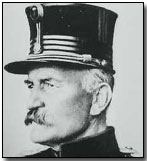Who's Who - Gerard Leman
 Gerard
Leman (1851-1920) ended the war as a national hero in his home country of
Belgium, despite having only seen service in the opening month of the war.
Gerard
Leman (1851-1920) ended the war as a national hero in his home country of
Belgium, despite having only seen service in the opening month of the war.
A military commander in the Belgian army and former military tutor to the Belgian King, Albert I, Leman was tasked with defence of the fortress at Liege against advancing German forces en route to France. Liege - together with its outer ring of satellite forts - occupied a vital position, blocking the narrow gap between the 'Limburg appendix' and the Ardennes, the best entrance into Belgium.
Given Liege's importance the German army had set in place special procedures for its capture, chiefly in the form of unusually heavy artillery, including the mammoth Krupp 42-cm howitzer, in addition to the use of Zeppelins in dropping bombs.
Somewhat dilapidated in design in any event, and certainly undermanned, the forts were reduced to rubble under the Germans' heavy artillery between 5-16 August 1914 in what was the first land battle of the war.
Nevertheless the stubborn defence thrown up by Leman and his defenders slowed the German advance (under von Bulow's Second Army) sufficiently for the action to be considered something of an Allied victory. Anything that slowed the rapid advance of the Schlieffen Plan was of vital importance in the early weeks of the war.
Leman himself was finally captured and had to be carried out of the fort wounded and unconscious. Having spent the remainder of the conflict as a German prisoner of war he returned to Belgium a hero following the 1918 Armistice.
While en route to Germany Leman wrote a letter to King Albert I, detailing the fall of the forts, and which he concluded by writing that "I would willingly have given my life the better to serve them [Belgium and its King], but death was denied me". Click here to read an extract from his diary of August 1914; click here to read a first-hand German officer's account of the fall.
The city of Liege finally surrendered on 7 August - to Erich Ludendorff, an action which established his reputation and set him upon his rapid career advance which shortly afterwards allied him with Paul von Hindenburg on the Eastern Front.
Shrapnel comprised steel balls ejected from shells upon detonation.
- Did you know?
